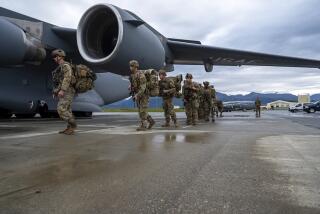Military Activity Accelerates, Especially Along Aleutians : Superpower Strategies Focus on Alaska
- Share via
ADAK, Alaska — Several times a month, squadrons of TU-95 Bear-H bombers fly out of bases deep within the Soviet interior and sweep along the Aleutian Islands or they head over the North Pole and then down toward Alaska. As they cross the Defense Early Warning Identification Zone, an imaginary line 50 to 200 miles off the Alaskan coast, American pilots scramble to meet them.
The rendezvous that invariably follows bears elements of aerial camaraderie, but the mission on both sides is deadly serious.
“We take our pictures when we find them, checking the antennae, looking under the wing that could carry a particular missile,” said Capt. Bill Shaw, an F-15 pilot based at Elmendorf Air Force Base near Anchorage. “Generally, the Russian pilots seem pretty friendly. They want you to rock up and wave. But we know they’re just out there to gather their intelligence and normally we don’t accommodate them by waving back.”
Outside U.S. Air Space
The Russians do not penetrate American air space, which extends three miles from the Alaskan shore, their tail guns are locked harmlessly in an upward position and their external missile racks are empty.
But their increasing activity--39 sightings so far this year, five more than in all of 1986--is clear evidence of the strategic importance of the North Pacific waterways along the Aleutian Islands.
It is an importance underscored by the growing presence of both superpowers in the North Pacific, an area where both Soviets and Americans are within short striking distance of the major oceangoing trade route between North America and northeast Asia and the polar route for airplanes between Europe and Asia.
At their closest point in this remote part of the world, Alaska’s Little Diomede Island and the Soviet border are less than three miles apart.
New Historic Role
James A. Lyons Jr., commander in chief of the U.S. Pacific Fleet, has declared that the strategic importance of this area cannot be underestimated. “In my view,” he said, “the needle of history is now pointing toward the Pacific.”
In discussing “the new North Pacific strategy,” Lyons said the Aleutian Island naval base is going to be more important than Keflavik, the U.S. base in Iceland, is to the Atlantic.
On Adak, 600 miles from the Soviet Union’s submarine base on the Kamchatka Peninsula, the Navy operates an air station and monitors Soviet submarine movements and missile tests. Along with Shemya Island, a secret Air Force base and listening post to the west, Adak gives American commanders forward positioning and a flexibility of movement that the Pentagon considers critical in the defense of the U.S. mainland.
For the first time ever, Lyons moved a carrier battle group into the Bering Sea 13 months ago, and reported that it operated for nine days without being detected by Soviet reconnaissance flights. And last January, 14,000 Marines and sailors, backed by 115 aircraft and 14 ships, conducted the first cold-weather assault exercise in the Aleutians since World War II. The burgeoning Adak base now is home for more than 5,000 military personnel, their dependents and other civilians.
Moscow Changes Tactics
Moscow’s interest in the region represents a change in tactics from 20 years ago when the Soviet Union’s Pacific fleet was the smallest and most obsolescent of its four fleets. In the last five years, U.S. Navy officials said, the Soviet Pacific fleet has grown to more than 400 ships and submarines, about 100 more than the U.S. Navy has in the area. Moscow also operates two air defense bases within 500 miles of the Aleutians, Anadyr and Mys Schmidta.
“What we are seeing is a buildup of the Soviet Union’s basic conventional capability and the fact that the Soviets have far, far outpaced us in our capability of defending the West Coast of the United States,” Sen. Ted Stevens (R-Alaska) said in a recent interview in Anchorage.
Stevens said the resultant American military buildup in Alaska has occurred for two reasons: “The increasing Soviet attempt to militarily dominate the North Pacific,” and an awareness of Alaska’s importance as a first line of defense and as a training ground for American troops.
Outranks Oil Revenue
Military spending now brings Alaska $1.3 billion annually, more than the state earned last year in oil revenues, and the military work force of 32,000 men and women, located at 30 installations, represents 12% of Alaska’s population. Including dependents, the military population is 92,000 or nearly one of every five Alaskans.
At Elmendorf, the Air Force this year has received six more F-15s, for a total of 33, and the older “A” model F-15s are being converted to “C” models, whose increased fuel capacity gives the fighters a range of 1,300 miles. The activation of an Air National Guard unit at Eielson Air Force Base near Fairbanks brings on line four KC-135 tankers that can be used to refuel the F-15s. Two E-3 Sentry AWAC reconnaissance planes also have been permanently based at Elmendorf since July, 1986.
“We’re finally getting the assets we need to do the job,” said Shaw, the pilot.
The Army’s presence also has grown. In March, 1986, the 2,000-man 173rd Infantry Brigade stationed at Ft. Richardson near Anchorage--”The Home of the Arctic Soldier”--was deactivated, and the 10,000-man 6th Light Infantry Division was activated. The new unit’s mission has been increased from simply the defense of the Alaskan mainland to include the initial defense of the Aleutians and the capability of worldwide deployment. The division’s headquarters are scheduled to be moved from Ft. Richardson to another Army base near Fairbanks, Ft. Wainwright.
New Radar Being Built
Construction will begin in 1989 on a $450-million radar system to be located at Glen Allen and Tok. Its signal reaches out 1,800 miles and can be used to monitor cruise missile bombers. The Air Force facility at Clear already is linked with installations in Greenland and England to provide an early warning if missiles were launched at the United States.
Alaskans--who are unusually receptive to the military presence--have good reason to be sensitive about their security. Their frontier location has left them vulnerable before, as many feel it does today. In 1942, Japan twice bombed Dutch Harbor in the Aleutians and occupied for more than a year several small Aleutian islands. After World War II, five U.S. divisions were based in Alaska, but over the years that military presence was gradually reduced to not much more than a housekeeping force.
Billy Mitchell’s Warning
Now, the growing military presence in the state echoes a warning sounded as far back as 1935. That’s when Brig. Gen. Billy Mitchell told the House Military Affairs Committee that Alaska was the “key point of the whole Pacific. . . . He who holds Alaska holds the world.” Few then took him seriously, and when Alaska’s non-voting delegate to Congress, Anthony Dimond, introduced a bill for $10 million to build air bases in Alaska, Congress dismissed his request as “pork barrel” politics.
Asked one congressman: “What would anyone want with Alaska?”
More to Read
Sign up for Essential California
The most important California stories and recommendations in your inbox every morning.
You may occasionally receive promotional content from the Los Angeles Times.










